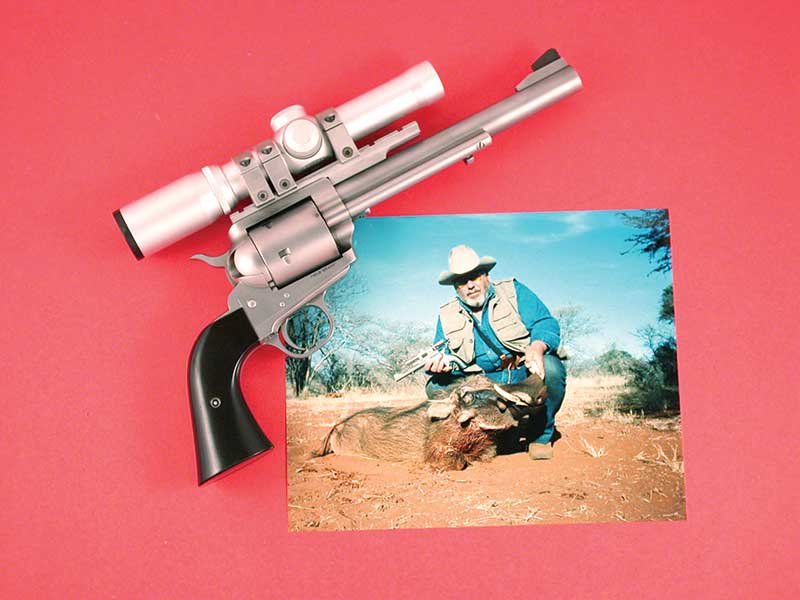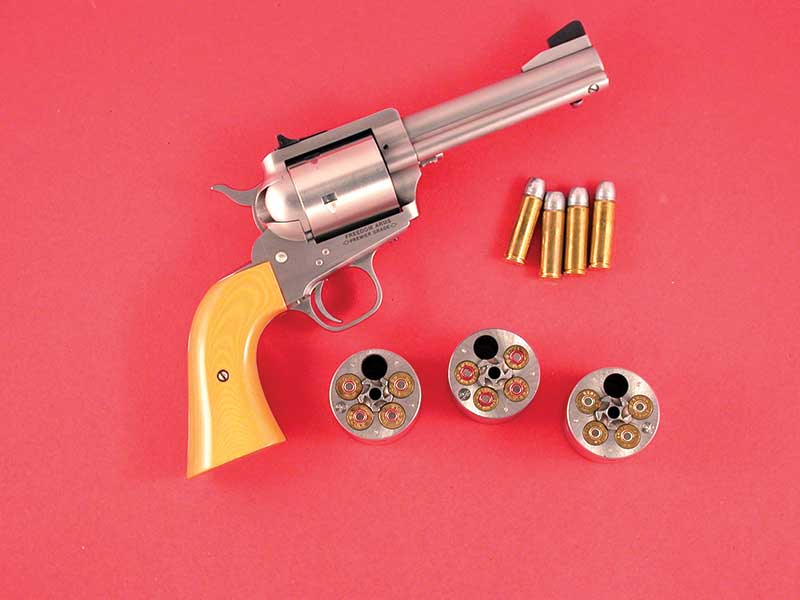A Half Century With Sixguns
The .454 Casull

After more than two decades and thousands of rounds, this 10" Freedom Arms .454 Casull
(above) still has a totally tight cylinder with no end or side to side play. The 4-3/4" Freedom
Arms .454 Casull is not only a top candidate for the title of Perfect
Packin’ Pistol (below) it is also made extremely versatile with the addition
of extra cylinders in .45 Colt, .45 Winchester Magnum, and .45 ACP.
The year was 1954. The words “under God” were added to the Pledge of Allegiance and the Dow reached an all time high of 382.74. Elvis was telling us That’s All Right, Bill Haley and the Comets sang Rock Around The Clock and Alan Freed, who read the comic strips to us on the radio every evening when I was very young, coined the term Rock & Roll. A new house cost $10,000, a new car was $1,700, polio was conquered by Jonas Salk, we were all going to see Blackboard Jungle, and a young Utah gunsmith by the name of Dick Casull was blowing up Colt Single Actions.
Casull, like Elmer Keith a generation before him, was an experimenter trying to come up with a truly powerful sixgun load. In 1925, Keith had blown up a Colt Single Action .45, switched to the .44 Special, had several custom Colt Single Actions built including his famous No. 5 SAA, and developed what would forever be known as the Keith Load. In the early 1950s Casull chose the .45 Colt because he considered its slow moving bullet a much better killer on game than the .357 Magnum, and also because .45 Colt brass was available in the solid head version while the .44 Special was still the old style balloon head. He would need the strongest possible case for what he wished to accomplish.
Ka-Blooie
The Colt Single Action was, and is, a marvelous sixgun. For me, especially in .45 Colt, it balances and points better than any other sixgun I have ever experienced. Casull played with several chamberings in the Colt from .22 Hornet, through the .44 Special, but eventually centered down on the .45 Colt. As great as the Colt Single Action is, .45 Colt cylinders are very thin on the outer walls and especially over the bolt slots. In pursuit of a more powerful .45, Casull bulged many cylinders; the cartridge case itself was sufficiently strong however the cylinder was not. In his work Casull used frame-mounted firing pins, special barrels and heat-treated frames, but no matter what he tried, cylinders burst and top straps blew just like they had done for Elmer Keith three decades earlier.
Not only did he have problems with the strength of the sixgun, he also found he had ignition problems with his loads. Primer pockets were reamed to accept rifle primers, however he did not have the right powders to accomplish what he expected with his .45 Magnum. Keith had ground black powder to an almost flour-like consistency to get as much power as he could from the .45; Casull went with triplex loads. The best powder available at the time was Hercules 2400, however it did not ignite satisfactorily and in fact gave erratic results and unburned powder granules. A triplex loading, consisting of three Hercules powders, Bullseye, Unique, and 2400 was developed. These powders were loaded in sequence and were held in place by compression. Since the advent of H110 and WW296 not only is triplex loading not necessary, the newer powders also provide better results.
Add Beef
Something had to be done to provide more sixgun strength. Special 5-shot cylinders were made as large as possible and still be able to fit the Colt Single Action frame window. By using 4140 steel, Casull was able to top Keith’s Heavy .44 Special load by 100 fps. Next came special heat treating of cylinders and frames. This allowed 250-grain bullets to be driven to 1,550 fps. (Remember this is even before the .44 Magnum arrived, however his goal was 1,800 fps.)
In 1957 Casull acquired special 1:24″ twist barrels from P. O. Ackley which greatly improved accuracy. He abandoned the 5-shot Colt and Bisley Model Single Actions and began building his own revolvers using 4150 steel for the cylinders and 4140 for the frames. Remember this is still with the standard .45 Colt brass and with the new sixgun he was able to get to 1,800 fps with a 230-grain bullet. In the February 1966 issue of this magazine in an article entitled “A Power-Packing Pistol: The .454 Magnum,” Casull was converting .44 Magnum Ruger Super Blackhawks to 5-shot .454s. Again, the brass was standard .45 Colt.
Freedom Arms
By 1972 Casull’s .454 Casull Magnum custom-built revolver was being offered through Rocky Mountain Arms and the triplex loaded ammunition used a 235-grain bullet loaded to 2,000 fps from a 7-1/2″ barrel. I don’t have any idea how many, if any, were actually sold to the public. A few more were offered in the late 1970s through North American Arms. Then Dick Casull hooked up with Wayne Baker and in 1983 the first Freedom Arms .454 Casull was delivered from the factory in Freedom, Wyoming. Along with the new sixgun there was also new brass, .454 Casull brass made longer than .45 Colt cases. This was done to prevent them from being used in .45 Colt sixguns.
My first article on the .454 Casull appeared in the July/August 1987 American Handgunner. To this day, this article still contains the most comprehensive load data ever offered on the .454. My first .454 Freedom Arms was a 10″ version. I had contacted Wayne Baker in early 1986 to obtain a test gun and that was one of the best things I ever did in more ways than one. Not only was this the finest single action to ever come from a factory, in June of that year Freedom Arms hosted the first annual Shootists Holiday. Ever since that time sixgunners have been gathering once a year to shoot together and share ideas.
Prolific Data
My first .454 Casull exhibited something I had never experienced in a revolver. There was absolutely no play whatsoever in the cylinder from either front to back or side to side. It’s simply locked up totally tight and the barrel cylinder gap was almost nonexistent. I loaded and shot, reloaded and shot over and over again. I used both cast and jacketed bullets and my first article featured 13 different bullets and more than 150 loads. It not only remained tight, it exhibited exceptional accuracy. Before the 1980s were out I also had 4-3/4″ and 7-1/2″ .454s and spent one summer developing more than 600 loads running each of them through all three sixguns.
In addition to developing the .454, Casull also designed two bullets and Lyman offered the molds. These were 260- and 300-grain gas-checked, flatpoint designs, numbers 454628GC and 454629GC. At that first Shootists Holiday in 1986, I shot alongside Dick Casull using his 12″ octagon barreled .454 and his loads with the 260-grain bullet over WW296 powder ignited by Remington Bench Rest Rifle Primers. Would you believe 2,344 fps! Casull’s 300-grain not only works well in the .454 it is my favorite heavy bullet for the .45 Colt in Ruger Blackhawks, although my loads are held at 1,200 fps in the 6-shot Ruger.
Using the Casull/Lyman 300 grain bullet over 32.0 grains of H110 in the 4-3/4″, 7-1/2″, and 10″ Freedom Arms Model 83s results in muzzle velocities of 1,600 fps, 1,700 fps, and 1,750 fps respectively. These are not what one would call pleasant shooting loads, however they are suited for the biggest of big game hunting. J. D. Jones also designed a line of SSK .45 caliber bullets and his 340 grain which was offered by NEI as #345.451 loaded over the same powder charge gives muzzle velocities of 1,600 fps, 1,775 fps, and 1,800 fps from the same three sixguns. The latter load should satisfy anyone looking for stout recoil.
More Guns
The .454 Casull is now also offered in Ruger’s Super Redhawk and the Taurus Raging Bull. Both of these sixguns are heavier than the Freedom Arms version and also feature rubber grips which help lessen felt recoil somewhat. Ruger’s .454 Alaskan with its 2-3/4″ barrel is designed to be an easy packing sixgun for up close situations. It also features rubber grips. Without them it would be awfully difficult to handle the recoil.
The .454 does not have to always be loaded to the hilt. In fact life is a whole lot more pleasant using lighter loads. Using 10.0 grains of WW231, Unique or Herco under 300-grain cast bullet gives muzzle velocities in the 1,100 fps range and is certainly adequate for feral pigs and deer-sized game. Freedom Arms revolvers can also be fitted with extra cylinders chambered for .45 Colt, .45 Win Mag, and .45 ACP making them exceptionally versatile. I expect to pass my three Freedom Arms sixguns to my three grandsons and all three of these .454s will pass on to future generations just as tight as they were when they first left the Freedom factory.





